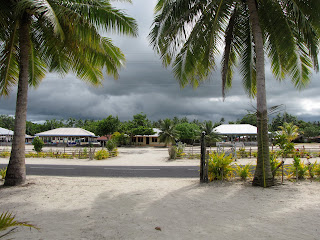
Jody VanDorp (Redeemer '11) writes:
The past week has included a lot of amazing moments, days, and new ideas. Last Saturday, all eleven of us (plus Lisa = twelve) drove down to Christchurch to witness our first professional rugby match. Our team (the Canterbury Crusaders) won, and many of us were very glad to have Lisa with us to explain the (sometimes confusing) rules. Abe and Marcel (SLC’s) were also at the game, and were chosen out of the crowd to be in the half-time show! We spent about 10 minutes distracted watching them as they were taught how to kick the ball etc. and then cheered loudly for them as they kicked (wearing sandals/barefoot!) On the way home, we pulled over for a few minutes to lay down and stare up in awe at the star-filled sky.
Monday brought a new class and a new professor, God and Nature with Steven Bouma-Prediger. We reviewed the groaning of creation, biblical texts that form a creational mandate, arguments to counter complaints against Christianity, as well as passages describing the beauty and order of creation. We were assigned several readings from Sex, Economy, Freedom and Community by Wendell Berry. I highly recommend it to all. I think it is safe to say that for all of us, our understanding of Christian stewardship was broadened over the past week. At the end of class each night, we also had an informal lesson in the ecological messages of children’s stories, as BP read us a bedtime story (ex: The Lorax, Yertle the Turtle, Just a Dream) before we went to bed.

Monday afternoon we all made our way to the beach, where some people were learning to surf. Once again, several of us remarked on the beauty of a small group so that we could all hang out together away from the convent as well.
For many of us, today was a highlight of our whole experience. On the coast to the south of Kaikoura is a huge island/rock about 500 m (little over a quarter mile) off shore. As we have driven past it, we have often seen people swimming out towards it and wanted to make the pilgrimage ourselves. Today was the day. Ten of us suited up (thank you to friends from church for many borrowed suits that kept most of the girls from having to rent) and headed out. Many thanks to Lisa and Allie for driving us out there, our contingent would have been smaller if we had all biked out. Alex did bike both there and back, fighting the headwinds on the way out.
We started the swim, a little shocked by how cold it was since there was no sun to heat things up for us. The waves were fairly large, adding all the more to the adventure. When we got to the appointed spot along the rock, we were greeted by a seal or two swimming in the water. Our presence invited a few more of them into the water, and as more of our group arrived, the number of seals also increased. We were swimming with seals!!! They seemed to like it when we were swimming, looping, etc underwater as they do. A few of them came very close, occasionally bumping into our fins and feet. We shrieked delightedly, not really able to believe that this was actually happening! They were so playful and beautiful; like Sea World but in real life and therefore way better.
It’s been a great day and a great week.











